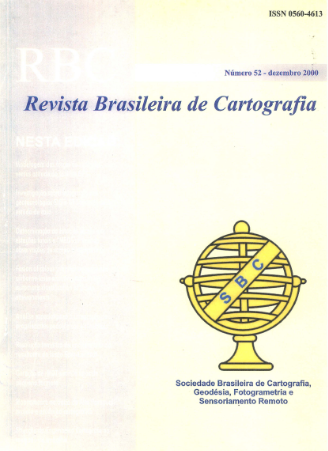Fusion of colour infrared imagery and airborne laser scanning data in the automatic classification of urban environments
Conteúdo do artigo principal
Resumo
The fusion of multi-sensor data important in the automatic classification of urban environments. In this study, the additional channel concept is used to fuse airbone laser scanning (ALS) data with a colour infrared (CIR) image acquired for a typical urban scene. To facilitate the co-registration of the two data sets is generated a CIR ortho-image using the digital surface model derived from the ALS data. This effectively integrates the geometric and multi-spectral information sources. In order to incorporate context analysis in the feature extraction, the feature base is expanded to include both spectral and spatial features. A maximum likelihood classification approach is then applied after an initial clustering procedure. Shadow effects present in the fused imagery are subsequently eliminated. Kappa related measures as well as accuracy parameters derived from Kullback-Leiber information on multinormal distributions are estimated. For comparison purposes, use is made of Delaunay triangulation. It is demonstrated that the classification of urban scenes is significantly improved by fusing the multi-spectral and geometric data sets.
Downloads
Detalhes do artigo
Edição
Seção

Esta obra está licenciado com uma Licença Creative Commons Attribution 3.0 Unported License.
Autores que publicam nesta revista concordam com os seguintes termos:
- Autores mantém os direitos autorais e concedem à revista o direito de primeira publicação, com o trabalho simultaneamente licenciado sob a Licença Creative Commons Atribuição que permite o compartilhamento do trabalho com reconhecimento da autoria e publicação inicial nesta revista.
- Autores têm autorização para assumir contratos adicionais separadamente, para distribuição não-exclusiva da versão do trabalho publicada nesta revista (ex.: publicar em repositório institucional ou como capítulo de livro), com reconhecimento de autoria e publicação inicial nesta revista.
- Autores têm permissão e são estimulados a publicar e distribuir seu trabalho online (ex.: em repositórios institucionais ou na sua página pessoal) a qualquer ponto antes ou durante o processo editorial, já que isso pode gerar alterações produtivas, bem como aumentar o impacto e a citação do trabalho publicado (veja "O Efeito do Acesso Aberto").
Como Citar
Referências
ANDERS, K. H.; SESTER, M.; FRITSCH, D. Analysis of Settlement Structures by Graph-based Clustering. In: FÖRSTNER, W; PLÜMER, L. Semantic Modeling for the Acquisition of Topographic Information from Images and Maps: SMATI 97. Berlin: Birkhäuser Verlag, pp.41-49, 1997.
BARNSLEY, M. J.; BARR, S. L. Inferring urban land use from satellite sensor images using kernel-based spatial reclassification. Photogrammetric Engineering and Remote Sensing, v. 62, n. 8, pp. 949-958, 1996.
BAUMGARTNER, A. Extraction of roads from aerial imagery based on grouping and local context. International archives of photogrammetry and remote sensing, v. 32, pp. 196-201, 1998.
CENTENO, J. A. S.; KISHI, R. T.; BÄHR, H.-P. Recognition of Buildings Using Scanned Maps and Laser Scanner Altitude Data. Photogrammetrie, Fernerkundung, Geoinformation, Stuttgart, v. 1, pp. 19-28, 1999.
CENTENO, J. A. S.; WEINDORF, M. Spatial information for image segmentation. In: XVII CIPA international symposium, 1999, Recife. Proceeding of the XVII CIPA international symposium. Olinda: CIPA, 1999.
FUNG, T.; CHAN, K.-C. Spatial composition of spectral classes. A structural approach for image analysis of heterogeneous land-use and land-cover types. Photogrammetric Engineering and Remote Sensing, v. 60, n. 2, 1994.
HAALA, N. Gebauderekonstruktion durch Kombination von Bild-und Hohendaten. 1996. Tese de Doutorado. Stuttgart, Univ., Diss., 1996.
HAALA, N.; BRENNER, C. Extraction of buildings and trees in urban environments. ISPRS journal of Photogrammetry and Remote Sensing, v. 54, n. 2-3, pp. 130-137, 1999.
HAALA, N.; WALTER, V. Automatic classification of urban environments for database revision using lidar and color aerial imagery. International Archives of Photogrammetry and Remote Sensing, v. 32, n. Part 7, p. 4-3, 1999.
HAHN, M.; STITTTER, C. A Scene Labeling Strategy for Terrain Feature Extraction Using Multisource Data. International Archives of Photogrammetry and Remote Sensing, v. 32, n. Part 311, pp. 435-441. 1998.
HARALICK, R. M.; SHAPIRO, L. G. Computer and Robot Vision, Volume I. Reading: Addison Wesley, 1992.
KUNZ, D.; VÖGTLE, T.; SCHILLING, K. J. Integrierte verarbeitung von satellitenbild-und vektorieller karteninformation. In: BÄHR, H. P.; VÖGTLE, T. Digitale Bildverarbeitung, v. 3. Karlsruhe: Wichmann Verlag, p. 220-242, 1998.
LILLESAND, T. M.; KIEFER, R. W.; CHIPMAN, J. W. Remote Sensing and Image Interpretation. New York: John Willey & Sons, 1994.
LOHR, U. Digital elevation models by laser scanning. The Photogrammetric Record, v. 16, n. 91, pp. 105-109, 1998.
NISHII, R.; TANAKA, S. Accuracy and inaccuracy assessments in land-cover classification. IEEE Transactions on geoscience and remote sensing, v. 37, n. 1, p. 491-498, 1999.
OKABE, A.; BOOTS, B.; SUGIHARA, K. Spatial Tessellations: concepts and applications of voronoi diagrams. New York: John Wiley & Sons, 1992.
POHL, C. Tools and methods for fusion of images of different spatial resolution. International Archives of Photogrammetry and Remote Sensing, v. 32, n. Part 7, p. 4-3, 1999.
QUINT, F. Kartengestützte Interpretation Monokuler Luftbilder, Dissertation, Deutsche Geodätische Kommission, Reihe C, Heft Nr. 477, München. 1997.
RICHARDS, J. Remote Sensing Digital Image Analysis. Budapest: Springer-Verlag, 1993.
SAFAVIAN, S. R.; LANDGREBE, D. A survey of decision tree classifier methodology. IEEE transactions on systems, man, and cybernetics, v. 21, n. 3, p. 660-674, 1991.
SCHILLING, K. J.; VÖGTLE, T. Satellite image analysis using integrated knowledge processing. International Archives of Photogrammetry and Remote Sensing, v. 31, n. 3, p. 752-757, 1996.
SERRA, J. Introduction to Mathematical Morphology. Computer vision, graphics, and image processing, v. 35, n. 3, p. 283-305, 1986.
WALD, Lucien. A European proposal for terms of reference in data fusion. In: Commission VII Symposium" Resource and Environmental Monitoring". pp. 651-654, 1998.
WELTER, V. Automatic classification of remote sensing data for GIS database revision. International Archives of Photogrammetry and Remote Sensing, v. 32, p. 641-648, 1998.
WEHR, A.; LOHR, U. Airborne laser scanning—an introduction and overview. ISPRS Journal of photogrammetry and remote sensing, v. 54, n. 2-3, p. 68-82, 1999.

